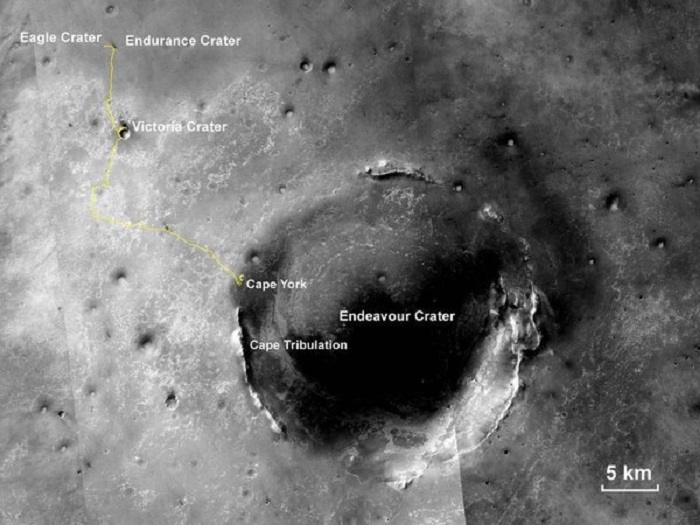.

This panorama from NASA's Opportunity rover, made on June 1, shows Solander Point rising up on the Martian horizon. Mission managers plan to get the solar-powered rover to a north-facing slope on Solander Point by August, so that it can shelter there during the Martian winter.
Opportunity rover finds traces left by 'water you can drink' on ancient Mars
.
Nearly 10 years after its launch, NASA's Opportunity rover has found its first evidence that Mars once had non-acidic water — the kind of water that could easily sustain the life we typically see on Earth.
"This is water that you can drink," Cornell astronomer Steve Squyres, principal investigator for Opportunity's long-lived Mars mission, told reporters Friday.
The water isn't there anymore, but the minerals left behind bear an aluminum-rich chemical signature that suggests they were formed through interaction with neutral-pH water. That's different from the previous evidence that Opportunity found, pointing to more acidic water. Some extreme forms of life on Earth could tolerate that environment, but it wouldn't have been as friendly an environment for prebiotic chemistry — the chemistry that's thought to have given rise to life on Earth.
The newly announced findings, based on X-ray analysis of a rock nicknamed Esperance, add to similar evidence of neutral water that was found on the other side of the Red Planet by NASA's bigger and more capable Curiosity rover. Taken together, they flesh out the story of a planet that was friendly to life's conditions early in its existence but became colder, drier and less hospitable as it lost its global magnetic field and much of its atmosphere.
How Mars lost its mojo
The mission's deputy principal investigator, Ray Arvidsen of Washington University at St. Louis, sketched out a scenario in which Mars had a more Earthlike climate in the planet's early years. But as the planet wound down, the rains stopped, the oceans dried up, and more of the water that was available on Mars percolated up from the subsurface. That water picked up iron, sulfur and other elements, resulting in a more acidic pH.
The differences in the mineral signatures seen by Opportunity in older and newer rocks probably reflect "the transition from the early wet Mars to the cold dry Mars," Arvidsen said.
.

NASA's Opportunity rover analyzed the composition of a rock called Esperance, highlighted in this Feb. 23 image, and scientists determined that the minerals found there were probably formed through interaction with neutral-pH water. That's in contrast to previous evidence from Opportunity pointing to acidic water on ancient Mars.
.
Arvidsen and Squyres were reluctant to talk about time frames for that transition, but Squyres speculated that the minerals seen in the Esperance rock were formed during the first billion years of Mars' 4.6 billion-year existence. He said the rock appeared to be older than the 14-mile-wide (22-kilometer-wide) crater where it was found, known as Endeavour Crater.
Opportunity, which was launched from Cape Canaveral in July 2003 and landed on Mars in January 2004, has been at Endeavour Crater for almost two years. Squyres marveled at the fact that the rover found the evidence for neutral water so soon after Curiosity found the same thing.
"It's really striking to me how similar are the stories that are being told by the rocks that were recently investigated by Opportunity at Endeavour Crater, and the rocks that were recently investigated by Curiosity at Gale Crater," Squyres said. He said that the decisions on site selection "paid off on both sides of the planet, almost simultaneously."
Squyres ranked the find at Esperance among the nearly 10-year-long mission's top four or five discoveries.
Opportunity's next stop
Now Opportunity is heading for a new destination on the crater's rim: a rise called Solander Point, where the rover is due to spend the Martian winter. The rover team wants to position Opportunity on a north-facing, 15-degree slope, which will make it easier for its solar arrays to soak up power. While it's at Solander Point, Opportunity will study a rich range of geological layers that could provide further insights into the Red Planet's history.
"We consider it Sol 1 all over again for Opportunity," said John Callas, the Opportunity mission's project manager at NASA's Jet Propulsion Laboratory. "Sols" are Martian days: Opportunity is currently on Sol 3331 of what was originally expected to be a 90-sol mission on Mars.
Callas said the rover is still working fine, except for some "arthritis" in its mechanical joints and a potentially worrisome computer issue he called "flash memory amnesia." The temporary memory loss was last experienced about two weeks ago.

